You’re there, at the site. Tent up, bed made. What’s next? Tea! We’re going to have a look at some of the different types of camping stoves, and which one is the best for your morning brew!
Tea, cleaning, dinner, boiling water is important to every camper. With no kettle, no microwave and no hob, how do you boil water? There are many options – go full caveman and build a fire, use a barbecue, or use one of the stoves we’ll be discussing.
For most people in their camping adventures, a gas stove or portable camping stove is going to be the best choice.
What are the different types of camping stove?
Broadly speaking, camping stoves tend to fit into three main categories: gas portable gas stoves, lightweight stoves and solid fuel stoves. Some may take all sorts of different fuel, but mostly they will each fit into one of these categories.
Camping stove comparison:
| Portable Gas Stoves | Lightweight Stoves | Solid Fuel Stoves | |
| Portable | not really | yes | yes |
| Easy to use | yes | most of the time | yes |
| Inexpensive | yes | prices vary from very cheap to extremely expensive | yes (in general, prices vary) |
| Stable | sometimes | no (although some more expensive brands are working on this) | no |
| Reliable | yes | yes | yes if the fuel is dry, no if the fuel is wet |
| Safe for older kids | yes, with supervision | yes, with close supervision | not really |
A portable gas stove
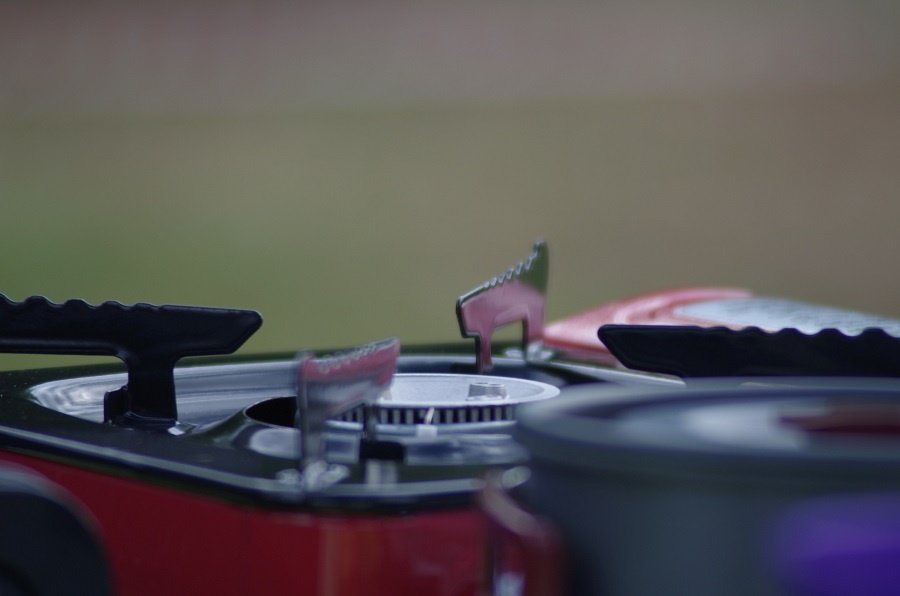
| Pros | Cons |
| – Quick – Easy to use – Full sized | – Bulky – Involves carrying gas – Canisters need a good-sized flat surface. |
The pros of a portable gas stove are that it’s easy. With the modern gas stoves with gas canisters, the canisters slot in, there’s an inbuilt spark to light the gas. No faffing with getting the right level and finding a lighter to light the thing. The top of the stove is about the same size as a domestic gas hob, so your stovetop kettle from home will do quite nicely.
The cons are that the stove is bulky. If you’re an ultralight camper or a motorbike camper, these stoves are not the best tool for the job. For general camping with a car, they’re fine, but not for small/light camping.
These stoves involve carrying gas canisters. These canisters look a lot like spray cans. They can’t be left in direct sunlight or in temperature extremes. Camping in the height of summer (or the depths of winter) make getting away from temperature extremes difficult. You’ve got to ensure that your canisters don’t get too hot or too cold.
Gas stoves need a good-sized flat surface to put them on. You can put them on the ground, but if the ground isn’t straight, be ready to watch your kettle or saucepan slowly slide off.
Gas stoves definitely have a place for the average camper. 80% of campers go in a car, have a nice site, and plenty of space, so size not an issue. For the other 20% – the ultralight/small pack/motorbike/backpack/hikers – gas stoves are a bulky heavy addition that can be swapped.
Ultralight stoves
These are small stoves that screw or push onto the top of a small gas canister.
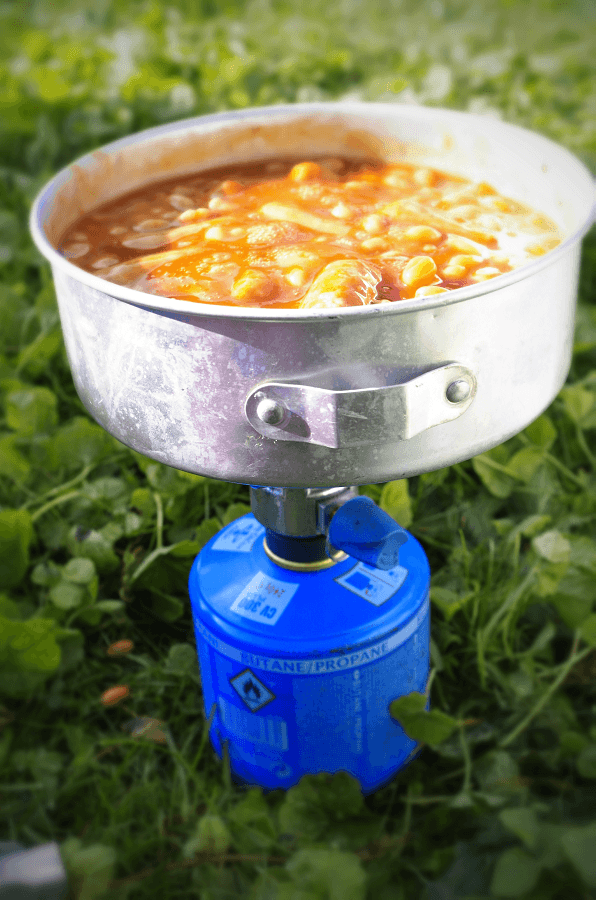
| Pros | Cons |
| – Lightweight – Easy to carry – Easier to fit in a small pack. | – Gas temperature – Rubber/Silicone seals – Getting it lit – bulky size – Bad stability |
Ultralight stoves have been around for a few years now. They fold up into small carrying cases and fold out when you want to use them. They either screw or push onto the top of a small gas canister.
The pros are their size and lightweight. They are great for the hiker/backpacker/micro camper. The gas canisters they fit onto come in a number of sizes, so are useful for shorter/longer trips. We think that the gas seems to last longer with these.
The cons are many, unfortunately. The lightweight stoves aren’t standard fittings, so some screw, some push-fit. This leads to the issue of the availability of the correct gas cannister. There’s no point having a screw fit stove when your gas cannister is push-fit, and vice versa. More than once my dinner has been delayed while we search for the right cannister or stove!
The gas canisters have the same issue as the spray can style – they are not designed to be used in extremes of temperature. They can’t be stored at temperature extremes either. The seals on the stove/cannister are usually rubber or a silicone type material. Rubber perishes when aged or in contact with oils. So there’s a high chance that the seals won’t last as long as you want them to if you’re an occasional user. Silicone seals also degrade over time. There are replacement gaskets and seals available, but again, there’s the issue of the right style/size. There’s always that chance that you could get your tent up, on the trail and find that your stove isn’t sealing. Not something you want after a long day’s hike and all you want is a cup of tea!
The small size canisters also have stability problems because your stove is sticking out of the top. With this style of camping stove, you’ll need to use smaller cookware than you can use with the gas stoves above. Larger or heavier saucepans are likely to tip, especially if the ground is not as flat.
You’ll need to remember a working lighter and/or matches to light the stoves. Trust me on this one, remember your lighter!
In summary, the foldable lightweight stoves are useful for the single/couple campers who want to maximise space. If you do your homework well on the type of stove/gas cannister then they’re great for a quick stop cup of tea. Not so much for cooking dinner.
Kelly Kettle
A Kelly/Volcano kettle has a fire at the bottom and a bottle on the top with a chimney in the middle.
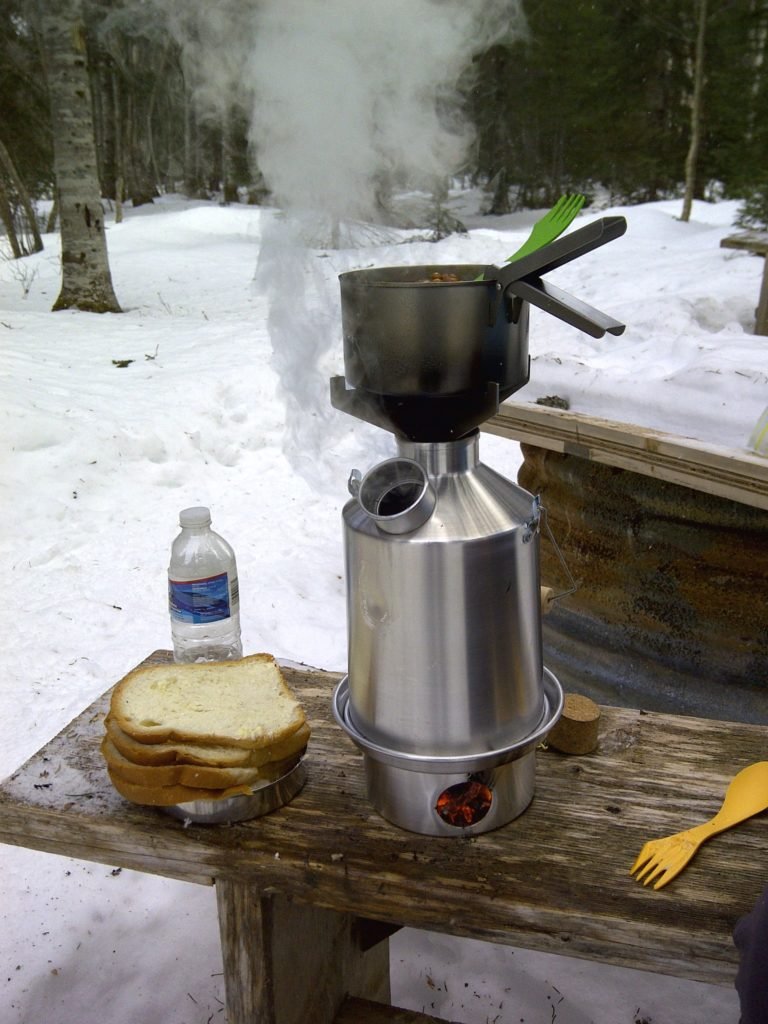
| Pros | Cons |
| – Quick – Easy to carry – Doesn’t use gas | – Difficult to light – Bulky – Only good for boiling water – Requires dry twigs |
Kelly kettles (also known as storm kettles, ghillie kettles and volcano kettles) are useful for people not wanting to carry gas. They’re ok for a quick cup of tea on the trail, or just boiling water for general use.
To use a Kelly kettle, you’ll need to find some dry twigs and kindling. Light the fire in the base, fill the water bottle and put it on top. The heat from the fire at the base rises through the chimney and heats the water from the inside.
The pros of Kelly kettles are that they boil quite quickly due to the heat from the fire reaching more water. They’re easy to carry – most Kelly kettles come in a carry bag that you can also put a lighter in. They don’t use gas, so if you are out in extreme temperatures, there’s no worry about gas failure or explosion.
The cons of the Kelly kettle are sadly numerous!
They are bulky. It’s a water bottle wrapped around a chimney, with a base. A 1L Kelly kettle is the size of a wide sports water bottle. They’re all metal, not foldable or collapsible and they can be difficult to light and keep lit for long enough to boil water.
I’ve found that you can only really boil water in them. They are not easy to clean out, so no soup! You also need access to dry twigs and kindling and on a rainy day, unless you’ve pre-planned, I’ve searched for ages with not much luck!
The Kelly kettle does have some cooking accessories. There’s a rack that fits in the top to put a saucepan on You can, theoretically cook food and boil water at the same time. Honestly, I’ve never managed it.
A bonus I have found though is that Kelly Kettles are virtually indestructible! They’re all metal and very very well made and sealed. I’ve never had one break or leak. It even works with dents. If you’re not careful with your kit or tend to do activities which might involve dropping stuff or running it over (green laners – I’m looking at you!!), then the Kelly kettle is a great stove. Otherwise, I’d go with something a little less bulky and a lot easier to light.
The Army Cook Set
Got to admit, this is my favourite stove! It’s designed for survival, to be portable, small and reliable.
| Pros | Cons |
| – Small – light packs down well – works fast – has a drinking cup, a water – bottle and eating cup integrated | – Takes solid fuel that might not be available/wet – Smell when cooking – Small – single person/single servings – no integrated lighter |
I have a British Army cook set (the crusader). It consists of four parts and a carry case. There’s the base, the water bottle, a plastic drinking cup and a metal cooking cup. All the parts fit into each other for easy carrying and easy storage. Solid fuel goes into the base, water goes into the cooking cup, which sits on top of the base and heats up.
The drinking cup is a really really good size! None of these little espresso sized camping cups, it holds a decent amount for a good mug of tea.
The cook set is perfect for hikers, backpackers, motorbike campers and single campers. The cooking cup is a good size and will easily make a meal for one. Drinking cup for tea, cooking cup for food – perfect.
Like everything else, the cook set does have its downsides.
It takes solid fuel (it can also take an alcohol burner/Trangia burner). Solid fuel can’t get wet and it smells a bit funny. It’s a bit fishy and unpleasant. However, the smell doesn’t transfer to the food. If your solid fuel is wet, it can be virtually impossible to light.
The size of the cook set could be an issue for groups or for more than one. It is only designed to provide for one person. So if there are two or more, they’ll need their own cook sets to get cups of tea at the same time.
Folding stoves
These are small, ultra-small solid fuel stoves that fold into themselves and end up about the same size as a pack of cards.
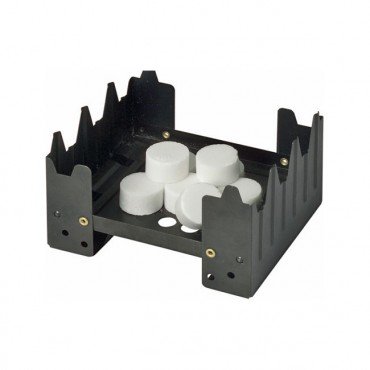
| Pros | Cons |
| – Size – Weight – Ease of use | – Not reliable – Need a flat surface – Stability issues |
Tiny folding stoves have not been around for too long, they’ve had a bit of a go over the last few years. They are about the size of a pack of cards when folded down and fold out to show 4 legs and a flat platform to hold the fuel.
These are really useful for the backpacker/hiker/motorbike camper. They take solid fuel (see the army cook set for the pros/cons). They are really easy to carry, being pocket-sized. You can usually fit a few solid fuel tablets in the folded stove, so it’s ready when you are. They are pretty much the smallest/lightest stove available at the moment.
However, there are many downsides to such a useful looking piece of equipment. It sits low to the ground, so you’ll need to find something to put underneath to fireproof the grass.
As with all solid fuel, the fuel tablets can be unpredictable. Sometimes they’ll burn evenly, other times the whole thing goes up at once.
The stove isn’t big enough for a decent-sized saucepan, but I’ve used a folding stove and an army mess tin (the rectangular ones). Stability is also an issue if your pot is too big. Again, as with the cook set above, these only really boil/cook enough for one person at a time, so groups will need one each.
So which camping stove to go for?
If you’re camping in the car, I’d suggest getting a standard camping stove with aerosol gas cartridges. If you’re hiking or backpacking (or it’s a long walk from the car to the campsite!) then go for one of the smaller lightweight options. Out in the wilderness for an undetermined amount of time? A Kelly kettle is for you!
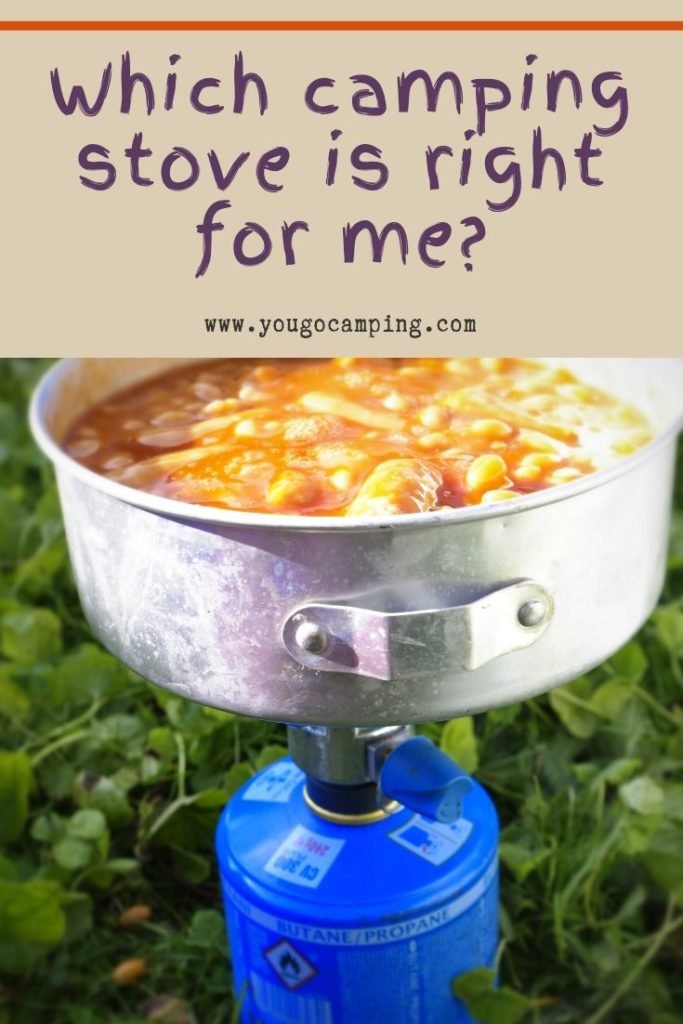
Did you find this article useful? Drop a pin on Pinterest!
If you really need an oven, sink and more than one ring on the hob – there’s always a caravan!
Overall, depending on your camping style, there is a stove out there for you – ultralight, backpacker, hiker, biker, family, car there’s a stove for all. It all depends on how much luxury you’re after.

4 Comments
How to stay warm when camping in the cold - Yougo Camping · October 13, 2019 at 11:57 am
[…] >Which camping stove is best for me?< […]
What are camping stoves used for? - Yougo Camping · October 16, 2019 at 6:16 pm
[…] are many different sizes and makes of camping stove, but we’ve made tea and coffee on all of them, and that’s the most important thing we look for; […]
4 Basic things to pack for your first time camping (bonus printable!) - · October 22, 2019 at 3:11 pm
[…] you’re not in your back garden, have a look at our camping stove article to see what stoves are available and have a look to see which one would suit […]
Campfire Cooking: How To Cook Outdoors - Yougo Camping · November 17, 2019 at 12:23 am
[…] at home, or it can be super exciting involving fire! We wrote an article a few weeks ago on the different types of camping stove available for, but today we’d like to expand on that a bit and discuss one of our favourite ways […]